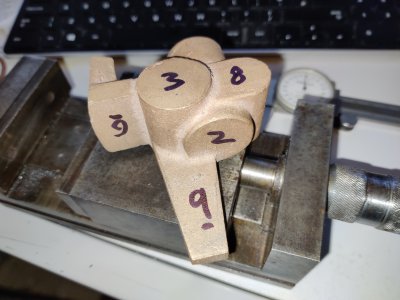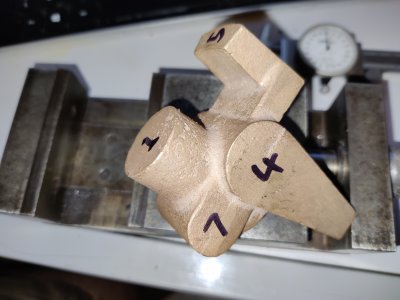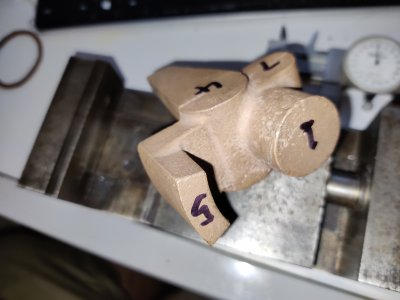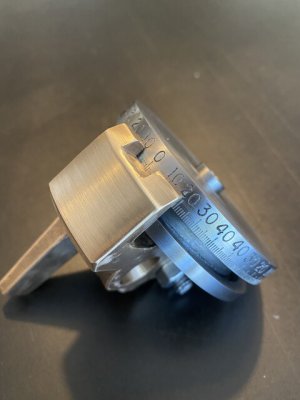- Joined
- Dec 23, 2019
- Messages
- 1,138
This thing is a swine:



Print attached.
The part is gunmetal and rather "gummy". This is a replacement as the orignal had a massive void in it and I messed it up when my setup moved. It tilts on the M8 through hole and has a rotating fixture that sits on top running in the M14 hole. The curving bracket protruding to the side is simply for graduations, not a working surface. As mentioned on (my) drawing, it's critical that the through hole and vertical hole are perpendicular. The large 45 degree chamfer is a working surface and must be exactly conentric and true with the 14mm bore. Yes, the pointer makes it a collosal b****** to hold.
Just spitballing really. What would you attack with a file? How would you hold? What surface would you bring in first? Mill or lathe? How would you ensure alignment? Face plate, 4 jaw or fixture? Order of ops?.... Shoot! I thought numbering the various "flat and complanar (hahahaha)" surfaces would be helpful in discussion.
As far as relavant tools go, I have a Myford lathe, Bridgeport, rotary table and Wohlhaupter boring head available to me. Clamps, Kurt clone and the precision vise pictured that fits in the Kurt jaws can be taken as read.
If you're curious, it's a part from a Quorn tool and cutter grinder. I have pics and will do a write-up on the entire build in due course. It's proving to be huge fun!
Props to Hemmingway Kits for supplying the replacement part. I bought the kit from ebay years ago as an "it's crazy cheap, will build one day" buy and they were still happy to supply the part to me for a very reasonable price.
Thanks for reading!



Print attached.
The part is gunmetal and rather "gummy". This is a replacement as the orignal had a massive void in it and I messed it up when my setup moved. It tilts on the M8 through hole and has a rotating fixture that sits on top running in the M14 hole. The curving bracket protruding to the side is simply for graduations, not a working surface. As mentioned on (my) drawing, it's critical that the through hole and vertical hole are perpendicular. The large 45 degree chamfer is a working surface and must be exactly conentric and true with the 14mm bore. Yes, the pointer makes it a collosal b****** to hold.
Just spitballing really. What would you attack with a file? How would you hold? What surface would you bring in first? Mill or lathe? How would you ensure alignment? Face plate, 4 jaw or fixture? Order of ops?.... Shoot! I thought numbering the various "flat and complanar (hahahaha)" surfaces would be helpful in discussion.
As far as relavant tools go, I have a Myford lathe, Bridgeport, rotary table and Wohlhaupter boring head available to me. Clamps, Kurt clone and the precision vise pictured that fits in the Kurt jaws can be taken as read.
If you're curious, it's a part from a Quorn tool and cutter grinder. I have pics and will do a write-up on the entire build in due course. It's proving to be huge fun!
Props to Hemmingway Kits for supplying the replacement part. I bought the kit from ebay years ago as an "it's crazy cheap, will build one day" buy and they were still happy to supply the part to me for a very reasonable price.
Thanks for reading!


